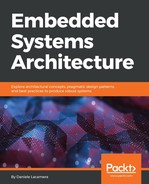As we know, standby allows the system to be frozen with the minimum possible power consumption, in the ultra-low-power range. The use of standby is advised when the design has very strict ultra-low-power requirements, when the following conditions are met:
- A viable wake-up strategy exists and it is compatible with the current hardware design
- The system can restore the execution without relying on its previous state, as the content of RAM and CPU registers is lost and the system restarts from the reset service routine at wake-up
Usually, longer periods of inactivity, where for instance the RTC can be used to program a wake-up alarm at a given time, are more fit for using the standby mode. This applies to cases such as reading sensors and enabling actuators at programmed intervals during the day, keeping track of the time and a few status variables.
In most other cases, the stop mode still allows for enough power saving, and provides a shorter wake-up interval. Another major advantage of stop mode is the increased flexibility for the wake-up strategy options. In fact, any interrupt-based or configurable event can be used to wake up the system from its low-power deep-sleep mode, so it is more fit for these states where there is still some asynchronous interactivity with the peripherals and interfaces surrounding the microcontroller.
